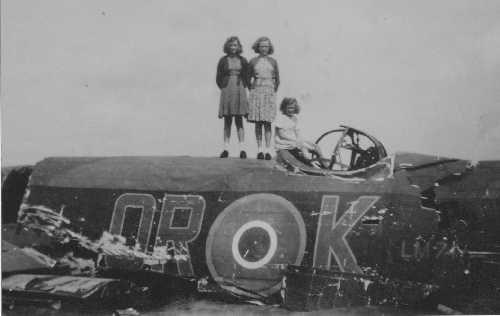Researching is fun. It’s like going on a Road-Trip and visiting all the second hand stores and museums in Saskatchewan. The topic never matters – the journey of ‘discovery’ does.
I try and confine my research to Moose Jaw and Saskatchewan but every once and a while I find stuff that is too interesting to overlook. Like this photo of three young girls standing on the remains of crashed RAF Lancaster Bomber QR-K, serial number LM718.

The photo appears in an incredible little Blog that can be found at: https://bakel-in-ww2.blogspot.com/p/lancaster-lm718-information.html
The children are the van Hock girls. Their parents owned the farm where the bomber crashed.
The story of RAF Lancaster Bomber LM718 is fairly straight forward.
On the night of September 23, 1944 it took off from RAF Squadron 61 Base at Skellingthorpe, Lincolnshire at 19:17 in support of troops and operations in Europe.
The Pilot was Squadron Leader Hugh Wilkinson Horsley, AFC, 68786 RAF. An experienced, dedicate and decorated airman.
The mission was “… to breach the Dortmund- ems Canal at Ladbergen just to the N of Munster.” (RAF Command). At 22:40 their Bomber was seriously damaged by a Luftwaffe Heinkel He 219 A-2 Night-Fighter crewed Hauptmann (Captain) Modrow and Feldwebel Schneider and operating out of an airfield at Munster-Handorf, Germany.
The order was given to abandon the aircraft by the Captain, Squadron Leader H. W. Horsley.
Of the seven-man crew, two were unable to bail out and were killed when the Bomber crashed on the farm van Hock near Deurne, Holland. Two were taken prisoner and three; S/L Horsley, P/O C.A. Cawthrone and Tail Gunner Sgt. R. T. Hoskisson survived; evaded capture and got back to allied forces. The three were returned to 61 Squadron in England.
P/O C.A. Cawthorne, DFM survived the war. Tail Gunner Sgt. R. T. Hoskisson rejoined S/L Horsley on more operations.
Sergeant R.T. Hoskisson was aboard Lancaster NF912, 61 Squadron on the night of Feb 1, 1945 when they took off from RAF Skellingthorpe at 15:42. They were fully loaded with bombs. Shortly after takeoff the outer port engine quit. The pilot, S/L Horsley brought the aircraft around to the Base for a belly landing on grass. They slid across the grass and then hit a taxi-way. The bomb load exploded.
Rear gunner Sergeant R.T. Hoskisson was badly burned but thrown clear. He recovered and survived the war. All others on board were killed.
Squadron Leader Hugh Wilkinson Horsley, AFC escaped to fight another day and died tragically doing so. Such was the character of so many in World War Two.
.png;w=304)



